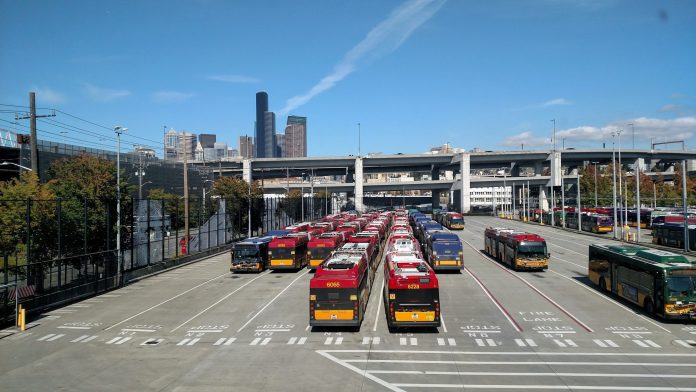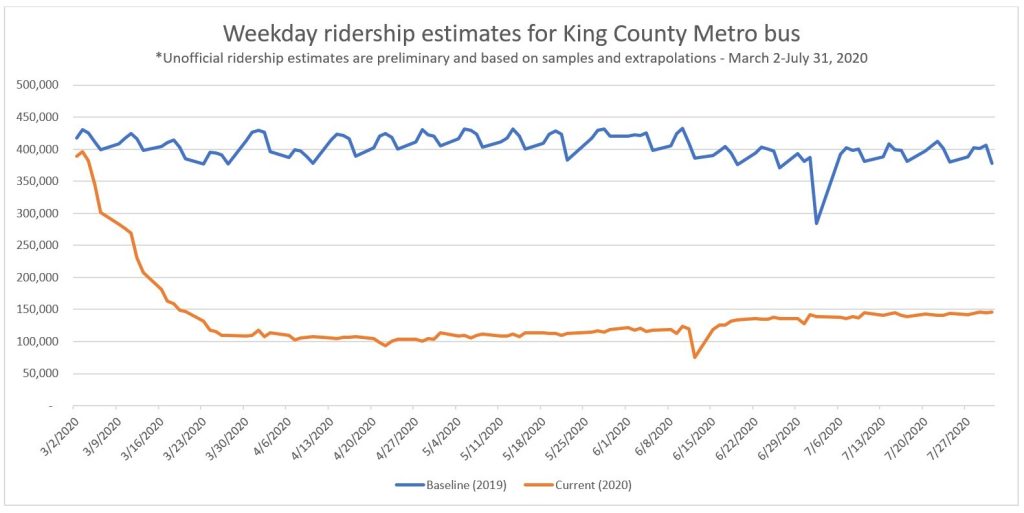
King County Metro riders will continue to enjoy fare-free rides through September. The agency continues to plan changes to buses that would allow fare collection to safely resume–and may open the door for increases in capacity limits. No date has been set yet to resume fares, Metro spokesperson Jeff Switzer said, but it’d be October at the earliest.
“As part of our ongoing improvements to our health and safety practices, we aim to install onboard mask dispensers and a plexiglass health partition between the bus operator and boarding customers over the course of the next several weeks,” Switzer said. “We don’t yet have confirmed rollout dates.”
We outlined some of the Covid safety changes implemented in planned in earlier coverage. The installation of the next round of alterations will be quite the endeavor since Metro operates more than 2,000 buses.
For now, Metro is continuing with Covid precautions it has in place.
“Metro’s response to-date has included daily disinfecting, requiring masks, limiting the number of passengers, supporting physical distancing, and providing our employees with personal protective equipment,” Switzer said. “The health and safety of our customers and employees has been and remains our top priority.”
Transit is low Covid risk
While some bus drivers did contract Covid early in the pandemic, it appears that physical distancing, back-door only boarding (save for people who need ramp access via the front), and sanitation measures are working for the most part and have limited the spread on buses.
Despite early fears that transit would be a transmission hotbed, later studies found little evidence that transit was linked to Covid spread, which suggests the risk is relatively low–particularly with the proper precautions of distancing and wearing a face mask.
Bus driver pay freeze canceled
Bus drivers’ gratitude for these safety precautions was likely tempered when King County Executive Dow Constantine sought to freeze their pay and back out of a deal with cost-of-living raises and a retroactive pay bump to trim the agency’s costs. The Amalgamated Transit Union–representing 4,600 members–successfully repelled the effort and got the pay increase deal honored, with the King County Council taking their side.
King County Council President Claudia Balducci did note some labor cost concerns in the longer-term: “I’m concerned about the idea of a large increase to the cost of labor, over the long term.”
The cost-of-living raises cost an estimated $78.5 million, Mike Lindblom reported, with the County forecasting sales tax losses will be $465 million over the next two years and $2.2 billion over ten years.
Sound Transit still charging fares
While Metro buses (and the Seattle Streetcar) will continue to be free, Sound Transit resumed fares on light rail on June 1st and on express buses on July 1st. Since light rail was on a very reduced schedule, that meant riders were paying just as much for sporadic and hard to rely on service. Luckily, Sound Transit announced it was ramping up service frequency earlier this month, with 15-minute or better headways promised during the day in September.
Ridership and the road ahead
Metro ridership was down 63% over last year by last tally due to the impacts of distancing measure on buses and society-wide. White collar commuter routes have seen the steepest declines, while routes that serve low-income areas and communities of color, such as in Southeast King County, have seen much smaller dips in ridership.

The looming question is whether budget constraints will force Metro to enact deep transit cuts, as the lack of fare revenue and lagging sales tax receipts starve the agency of resources–not to mention the risk of transit-cutting Initiative 976 being upheld by the Washington Supreme Court and blowing an even bigger hole. The Seattle Transportation Benefit District renewal on the ballot in November should help limit the damage, assuming it passes, but it can’t single-handedly turn the tide in Seattle, let alone countywide.
The King County Council set a farebox recovery ratio target of 25% for fixed bus service, meaning nearly a quarter of revenue for buses has pretty much evaporated. The fare holiday since March may reopen the conversation around lowering or eliminating fares. Regional fares are normally a relatively high $2.75 flat fare on Metro services, with limited options for all-day passes and the ORCA Lift reduced fare program only for qualifying riders below 200% of the federal poverty line.
Transit advocates will look to help from the Feds and from Olympia to stabilize finances and allow lower fares. Too bad, the Washington State Legislature hasn’t been of much help on transit, instead focusing on highways. Hopefully, legislators recognize it’s time to make wiser, more climate-conscious investments.
Correction: This article was corrected to note that the bus driver pay hike did go through in a 8-1 vote of the King County Council in July.
Doug Trumm is publisher of The Urbanist. An Urbanist writer since 2015, he dreams of pedestrian streets, bus lanes, and a mass-timber building spree to end our housing crisis. He graduated from the Evans School of Public Policy and Governance at the University of Washington in 2019. He lives in Seattle's Fremont neighborhood and loves to explore the city by foot and by bike.

